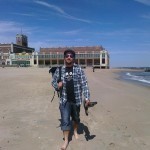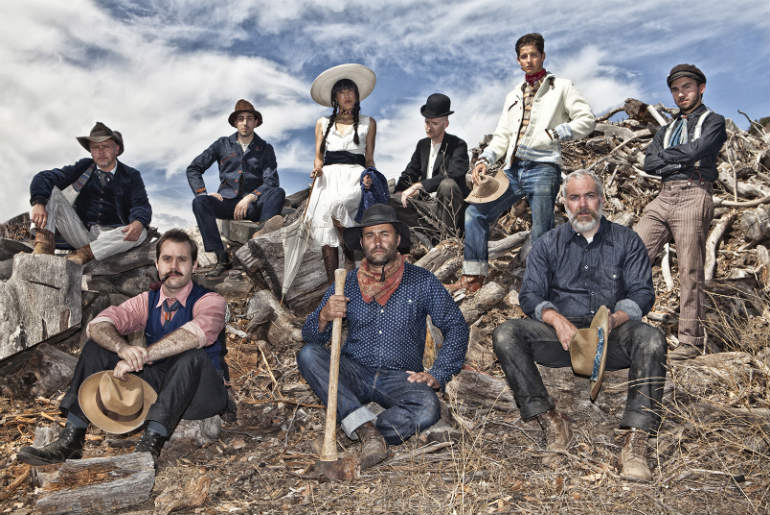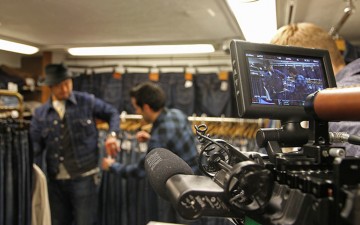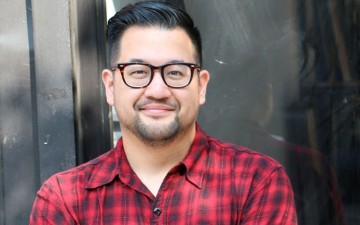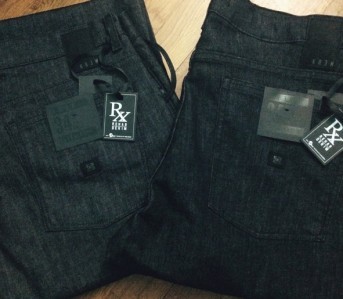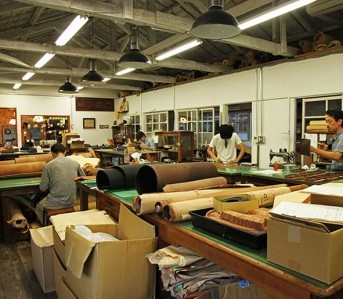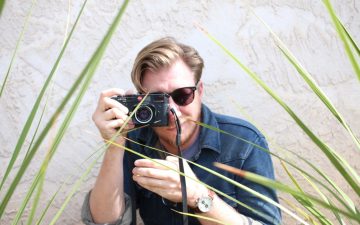See the first two parts of our interview with Cory here and here.
Cory Piehowicz clearly loves denim and its history. He has ingrained himself into the culture as both an aficionado and a contributor. As a perfectionist, the details are everything for him–something beneficial for his career, as he has developed a keen eye to go along with his technical understanding of a camera. Reveling in the dirt and the desert, the Bandit’s talents yield wondrous results.
However, for all of his talent, attention to detail and love of the rough and tumble, one thing he is most certainly not is a zoologist. What the hell does this have to do with photography? Well, when you have friends who enjoy the outdoors as much as you do, photographing in the “Old West” becomes quite common. One such photo shoot was done for fun with friends, Christophe Loiron and his Mister Freedom wares. As our feature image above was being taken, some nice park rangers visited the fair group.
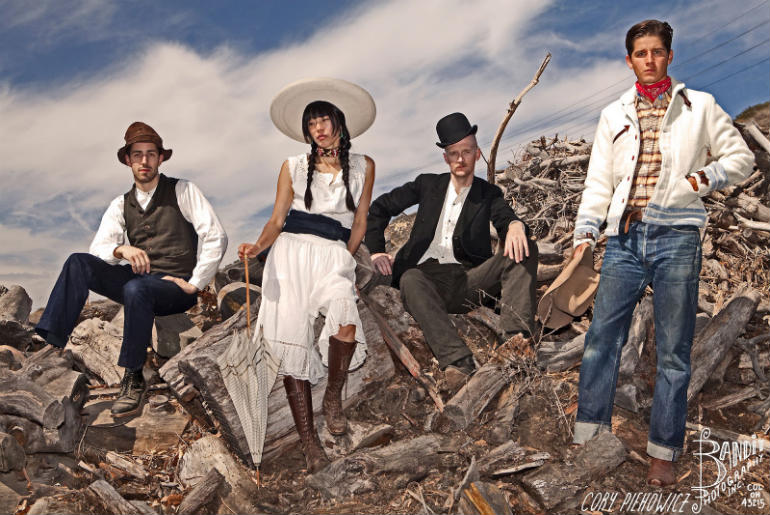
“You do realize that there are rattlesnakes right underneath you,” one of the rangers informed them.
“I hate rattlesnakes, too,” Piehowicz recollected with a grimace. “We should have known, considering how hot it was that day the type of area it was.”
Hopefully he’ll keep a closer eye on the terrain in the future. In the meantime, Heddels brings to our readers the conclusion of our interview with the Bandit Photographer.
RD: Why do you take the time to make videos such as your duck waxing video?
CP: I think it’s the same as with my blog, showing people how stuff fits. At one point I was interested in learning how to wax something and when I searched for it, it was a bunch of people making homemade stuff with turpentine and beeswax. There wasn’t too much out there. So I was interested in showing people how I do it. I’m not going to say that it’s the right way or the wrong way, but it’s worked for me. Why not help people out?
RD: What equipment do you use exactly for your photography?
CP: I use the Canon 6D. The lenses I’ll used are 24-70mm and 70-200mm L series. For film, I use a Hasselblad or the Mayima RZ67 and a 4×5 crown graphic.
RD: When you use film, what type of film?
CP: If I’m going to use film, I’m going to use medium format, because that’s what I see as the only advantage is the size of the negative because it’s going to be a bigger negative. So if I’m going to take the time to shoot film, it’s going to be a medium or large format.
RD: Any particular brands?
CP: Nah, just whatever is available. To me it doesn’t matter. You take what you can find. It’s the post-processing that matters more than what type of film. Back in the day when I was using film for black and white I was using Tri-X because of the super high contrast that I love for everything that I do.
RD: Why color over black & white?
CP: To me they’re both beautiful for sure, but the reason I use color is I love the rich colors that you find in clothes that guys used to wear. The calicos and the reds/blues. I mean, you see the photographs that I collect with all of the clothing, but you don’t get to see what it really looked like because they’re in black and white.
There are projects that I’ll decide to shoot black and white that I wouldn’t shoot with a digital camera. You can’t just convert a color photo to black and white though with digital, it doesn’t look quite right. It takes work to to make it look correct.

RD: What makes you decide to shoot a project in black and white then?
CP: Usually it’s strictly the lighting at the location.
RD: How do you decide what props to use for a shoot that you are in control of?
CP: Props for a shoot are definitely important. The more props that you have the more action – editorial related stuff is going to look better. If you get a person holding just holding a bag, it might look forced, but if they’re walking with the bag… You pick stuff that is visually interesting; it just looks better to a degree.
You still want things to be simple, but if you look at other photo shoots you always have a good location, something that you’re sitting on, a box or something, and then you’ve got stuff in the background, pictures on the wall, a good flag perhaps. You’ve got to keep in mind every single thing. With photography, all of these elements are essential. The more you think about, it’s going to turn out better.
RD: Now, being a fan of documentary photography, you mentioned that it could start to look forced. Do you ever look back and have things you regret?
CP: Yeah… I’ve questioned some stuff when I look back at shoots. But, I think it’s ultimately your eye that is going to help prevent something from looking forced. If I see something looks forced I won’t use it, I’ll cut it out. If you look at movies, movies are loaded with props. In There Will Be Blood, trains, oil, I mean, it’s loaded with cool stuff. Everything that makes a good photocomposition: location, lighting, props, etc. it plays its part.

RD: So when you look back at your old photography, do you see any of your old personality there, some evolution?
CP: Definitely some evolution, you grow as a photographer with each year and with the time you grow. I see stuff I hate that I shot originally. There’s photography 101: people want to go to graveyards, do suicide photos – they want to do baby pictures, dog pictures, flower pictures and train track photos.
Now fortunately for me I don’t mind the train track photos so much because it works with a guy dressed just so with workwear. But that’s instead of some person sitting around smoking a cigarette or walking down the tracks. Everyone does those types of photos and when they look back they wonder why they shot them. But then you move on to something new from there.
RD: What’s the hardest thing about doing commercial photography?
CP: Commercially photography is getting something that the client wants. Sometimes someone will hire you for your style and you shoot and they’re telling you it should’ve been something else. I can shoot a variety of different stuff outside of what you normally see me do. I used to shoot some Claiborne outlet stuff that’s completely different, and I thought we killed it. But commercial photography is tough because you don’t have the same control.
RD: What is the benefit of having an assistant for a project?
CP: There’s a lot of things, if you’ve got an assistant you’ve got someone to hold up reflectors, you have someone who can set up lights, grab something that might have been forgotten–shoes, a shirt. That’s always good. And if you’ve got a second shooter that’s good too. Though with that, if I’m shooting for a clothing company and I’ve got a second shooter and we end up using his photos…
RD: The credit issue.
CP: Right. With weddings or whatever it’s fine; it’s a whole other thing. You want to make sure you’ve gotten as much coverage as possible. They’re getting one thing while I’m getting something else. But yeah, other than (the credit issue) assistants are always good to have.
RD: You are a self-described perfectionist, what do you require in each of your works for it to meet your standard? Do you always find something that you don’t like in a photo? I think that the problem with me is I always become attached to my work.
CP: To me, personally a lot of it means something or there’s the experience that I had while shooting and I can’t separate myself from it. So editing is very hard, a pain. I’m working on my website now and I’m learning that because a prospective client doesn’t want to see 50 images of the one thing, you need to cut it down to only three or four examples. For me that’s hard.
I’m very bad at that and separating myself (laughs). Yeah there’s some stuff that, when I go back and take a look I don’t like it, but for the most part I’m pretty happy with my work. I don’t think I’ve had a really bad photo shoot for a while, which is good. With digital now there’s so many ways to correct stuff, it just needs to be within a range.
RD: What do you look for in a model for a photograph? Is there a classic feature, a certain flaw, trait or otherwise?
CP: I definitely look for classic and you look for characteristics in people. I don’t want to say I’m attracted to grotesque stuff, but I’m into rugged… to me wrinkles are great, eyes are important – any facial feature I’m definitely attracted to and it’s definitely important. If you look at all the main photographers and the famous photographs throughout history, a lot of those people are definitely characters, you don’t want boring.

RD: You have a degree in film; do you find you derive your photo methodology primarily from your education or from your experience over the years?
CP: No one really taught me how I shoot, I’ve always had the same style, the desaturation, high contrast, super clear, low depth of field – and when I say that people get confused but it means that the focus is on the person’s face being clear and not the background – I mean I grow every year as a photographer, but my style has always been the same.
RD: Do you think you could have been the same photographer without school?
CP: Yeah to be honest with you, no one really showed me how to do what I do. I started with street photography and I grew into what I do once I picked up a lot of old photographs and saw different traits in them.
School especially never taught me much post-production, no Photoshop, I still don’t use Photoshop that much, only a teeny bit. School forces you to create projects and prevents you from getting in little ruts that can happen and from getting rusty, but a lot of evolution happened after school.
RD: You mentioned how everyone thinks himself or herself a photographer these days; do you have any fear that professional photographers will be phased out (At least commercially) in the way that has occurred with other media?
CP: That’s a hard one. You will always have to have photographers with a good eye. It’s very important now… I think that with phones and cheap cameras now that are being used… it kind of cheapens photography somewhat.
RD: Do you think that digital technology is hurting more classically trained photographers?
CP: I guess I don’t want to say it cheapens photography but it gives everyone a handicap and you know, eventually they’re going to have a camera that takes a giant picture that you select where you want the focus.
RD: They’ve essentially got that with the new 43 mega pixel camera phones
CP: Right, and that’s the scary part. But you still need to capture a moment. Another thing though is Red Cameras that are being used to film commercials. Those cameras are such good quality that you can take a still from that and now you don’t need a still photographer. That’s kinda scary too.
But whether you have the photographer shooting or whether it’s someone who has a photographer’s eye, be it an artist or whatever, you’re always going to need someone who knows what looks good… it’s scary though I’ll tell you that (laughs).

RD: So you’ve modeled for a lot photographs for yourself, and a lot of people have associated you with a certain rugged modeling. Would you ever consider doing that for a career?
CP: I mean, yeah definitely. I think I have an advantage because I’m young enough to a degree, I’m still in good shape. I’ve got some gray hair and a beard, which helps, for a certain look people may be interested in.
RD: Would you ever accept an offer to be the new Gorton’s fisherman model?
CP: (Laughs) Sure, whatever man. I mean look at the World’s Most Interesting Man, right?
RD: So, to wrap things up, any goals for next year?
CP: Definitely finish the book and get it published. And I have a few personal projects art projects that I would like to do in the next year. Keep shooting as much as I can. Finish working on my webpage, keep doing my blog and find as much work as possible. Oh, and I’ll want to go back to the desert.
Special thanks to Cory for taking the time to talk and share his world. Piehowicz has even more to offer, though, so check out his website and Bandit Photographer blog to keep track. All photos courtesy Cory Piehowicz.
